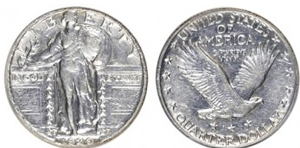Standing Liberty Quarters (1916-1930)

| Metal Value | US$ 3.702 |
| COMPOUND COMMODITY | COIN WEIGHT | COMPOUND WEIGHT % | COMMODITY PRICE | METAL VALUE |
|---|---|---|---|---|
| Silver | 6.25 Grams | 90 % | US$ 14.88/ounce | US$ 2.952 |
| Copper | 6.25 Grams | 10 % | US$ 34.0128/ounce | US$ 0.75 |
| MINT SPECIFICATIONS | NA |
| OBVERSE IMAGE | NA |
| REVERSE IMAGE | NA |
| METAL COMPOSITION | Silver : 90% Copper : 10% |
| WEIGHT | 6.25 Grams |
Silver Standing Liberty Quarters were first struck in 1916. However, those coins were not released into circulation until the following year. The quarters were produced annually from that point on through 1930 with the exception of 1922 in which none were minted. Both the obverse and reverse of the coins were designed by sculptor Hermon Atkins MacNeil.
Standing Liberty Quarters are composed of 90% silver with a total of 0.1808 ounces of the precious metal (current melt values for the coin may be found using the calculator in the right column). The 6.25 gram coins showcase an image of a standing Liberty on the obverse and a flying eagle on the reverse.
In 1890, Congress passed legislation allowing the U.S. Mint to change the design of circulating coins every twenty-five years without the need for Congressional intervention. That law initially brought about new half dollars, quarters and dimes in 1892 — all designed by Mint Chief Engraver Charles E. Barber and basically feature the same obverse of a bust of Liberty.
That same law would allow changes to those coins in 1916, and steps to do just that were undertaken by the U.S. Mint in 1915. Near the end of that year, a meeting was called between members of the United States Commission of Fine Arts (CFA) and Mint officials, including Barber who was still at the Mint. Design proposals by Barber for a new quarter met with resistance from the Commission and they were asked to select sculptors to submit new candidates.
One of those sculptors was Hermon Atkins MacNeil who was chosen to design the new quarter. He submitted his designs which were apparently significantly altered by the U.S. Mint. It showed a standing Liberty coming through a small gate. Initial strikes in 1916 had Liberty bare-breasted, holding a shield in one hand and an olive branch in the other. These are known today as Type 1 strikes. Obverse inscriptions include 'LIBERTY', 'IN GOD WE TRUST' and the year of minting.
Shown on the reverse was the image of a flying eagle. The eagle is surrounded by the inscriptions of 'UNITED STATES OF AMERICA', 'E PLURIBUS UNUM' and 'QUARTER DOLLAR'.
Once MacNeil was made aware of the changes that he felt were too artistic in nature, he immediately relayed his concern to U.S. Mint officials who wanted to avoid any controversy. As such, they allowed him to make further adjustments to the design to oblige him and these Type 2 strikes were first minted in 1917. The adjusted design showed Liberty with chain mail covering her chest.
Standing Liberty Quarters were issued by the U.S. Mint until 1930 and were replaced in 1932 by quarter dollars depicting the first President of the United States, George Washington. A full collection of the Standing Liberty Quarters can be hard to obtain as a key strike in the series (the 1916) featured a mintage of only 52,000.
Values vary drastically for the coins, but even the lowest quality versions (typically termed junk silver coins) still have real value owing to the fact that each was produced with 0.1808 ounces of silver.
SILVER STANDING LIBERTY QUARTER SPECIFICATIONS
Composition: 0.900 silver, 0.100 copper
Silver Weight: 0.18084 troy ounces
Total Weight: 6.25 grams
Diameter: 24.3 mm
Thickness: 1.75 mm
Edge: Reeded
Produced in U.S. Mints: Philadelphia, Denver, and San Francisco
- Filter by category
- Gold Coins
- Silver Coins
- Copper Coins
- Zinc Coins
- Nickel Coins
- Platinum Coins
- Palladium Coins
- Steel Coins
- Filter by country
- China Coins
- Georgia Coins
- Israel Coins
- Laos Coins
- Mongolia Coins
- Philippines Coins
- Cameroon Coins
- Congo Coins
- Ivory Coast Coins
- Liberia Coins
- Niger Coins
- South Africa Coins
- Austria Coins
- Belgium Coins
- Denmark Coins
- France Coins
- Germany Coins
- Hungary Coins
- Ireland Coins
- Isle of Man Coins
- Italy Coins
- Netherlands Coins
- Norway Coins
- Portugal Coins
- Russia Coins
- Spain Coins
- Sweden Coins
- Switzerland Coins
- United Kingdom Coins
- Bermuda Coins
- Canada Coins
- Mexico Coins
- United States Coins
- Chile Coins
- Peru Coins
- Australia Coins
- Cook Islands Coins
- Fiji Coins
- Niue Coins
- Palau Coins
- Samoa Coins
- Tonga Coins
- Tuvalu Coins
